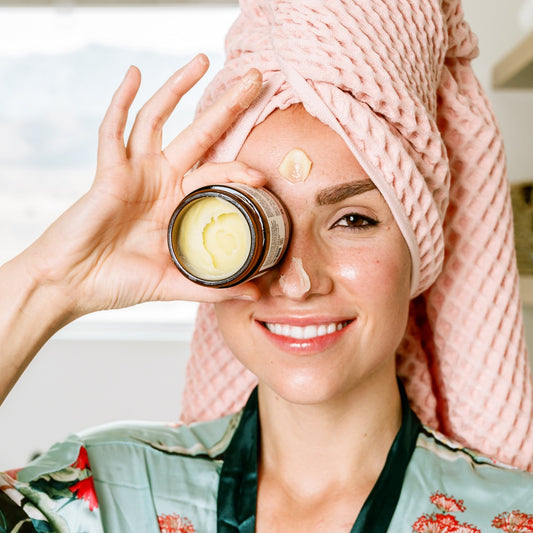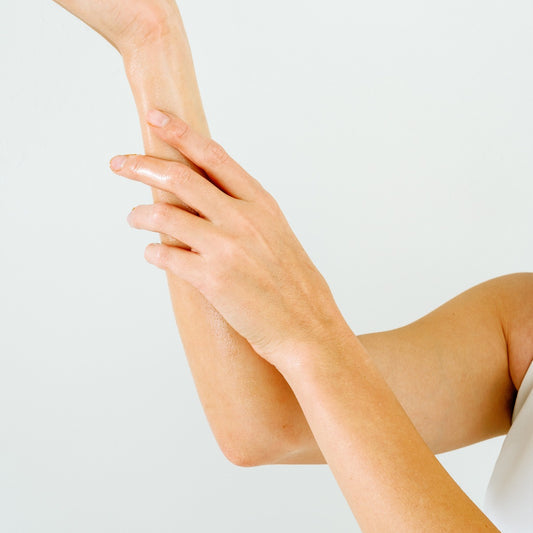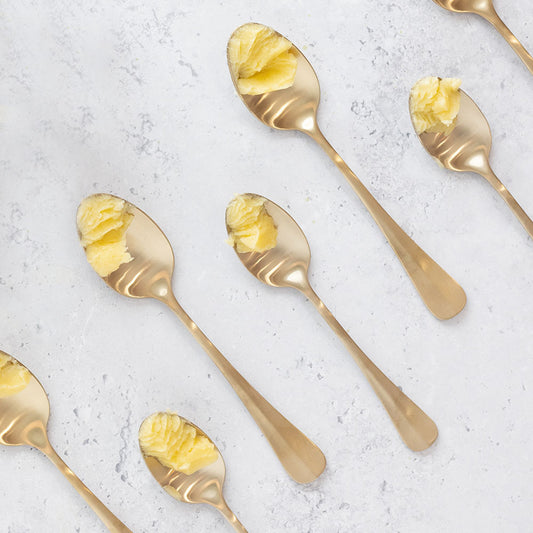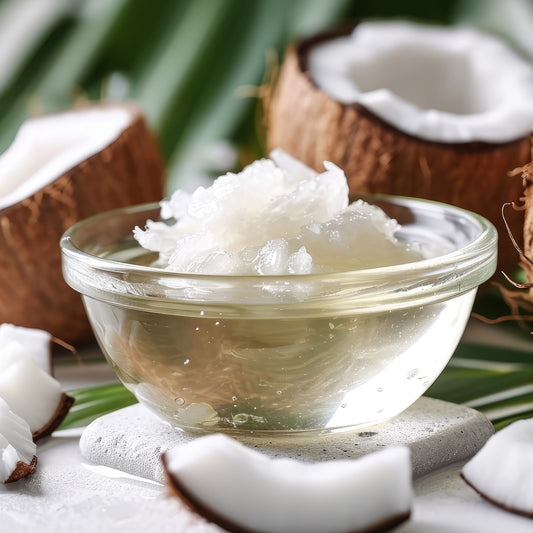The beauty and personal care market is worth more than $80 million annually,1 yet it is one of the least regulated industries in the United States. Often, off-the-shelf products contain a bewildering array of chemicals, many of which are known or suspected carcinogens, neurotoxins, endocrine disruptors, or harmful to our health in other ways. 2 Even though we usually assume that products like shampoos, face creams, and toothpastes are tested and determined to be safe, it unfortunately is not always the case.
Thankfully, there are many companies that make wonderful, healing products with the consumer's health in mind. Or, if you feel inspired, you can easily create your own!
What Is Your Skin Telling You?
Beautiful skin is the result of your whole body being healthy from living in harmony with nature, practicing nourishing habits, and eating wholesome foods. We can determine a great deal about our health just by looking at the skin on our face.
For example, we can notice if it is dry or oily, smooth or rough, cool or warm, pale or ruddy, or if there are any lines and where they are located. Every line, freckle, groove, and mole has a meaning. 3
In addition to a healthy lifestyle and diet, choosing organic, wholesome ingredients to put on your skin will go a long way in creating radiant skin and, in the long term, help with your overall health.
Ayurveda recognizes that we all have unique needs, and this philosophy allows us to customize which ingredients and routines would most benefit our skin type.
After learning how to determine which skin type you have, we'll look at cleansing, exfoliating, and nourishing recipes you can easily make at home. These simple practices will keep your skin looking soft, supple, and radiant.
“Beauty is the illumination of your soul.”
Vata, Pitta, and Kapha Skin Imbalances
The characteristics of our skin are often connected to our unique constitution, but when we experience imbalances in our health, it is common to see changes in our skin as well. If you are unsure of your constitution, or which

When and How to Cleanse Your Skin
Cleansing is an important part of your skincare routine, and it can be done on an as-needed basis. As a general rule, only use soap when you have perspired a lot or are literally dirty or greasy. There is usually no need to use soap on your face. Here are a few simple homemade cleansers you can make and use daily:
Vata-Type Skin
Make a paste made of 1 teaspoon of oatmeal or chickpea flour mixed with 1 teaspoon milk or cream and a little powdered rose petals or licorice. 4 Gently massage the cleanser onto your face and rinse it off. Another way to cleanse dry vata skin is to massage sesame oil on your face, then apply a warm wet washcloth for a minute or two for a steam treatment, and gently pat dry.
Pitta-Type Skin
Combine 1 teaspoon chickpea flour with ¼ teaspoon of either powdered triphala, neem, or rose petals, and add just enough water or lemon juice to make a paste.
Kapha-Type Skin
Apply a mixture of 1 teaspoon raw honey and ½ teaspoon lemon juice. Honey retains moisture and supports all aspects of the skin biome,5 while lemon helps tone and cleanse the tissues. Rinse off with warm water and pat dry.
Nourishing Your Skin
Gently massaging oil on your skin after cleansing provides nourishment, boosts circulation, carries away impurities, and reduces signs of stress and tension. Adding a few drops of pure, high-quality essential oil can further boost the benefits of your moisturizing carrier oil.
For convenience, mix 4 ounces of carrier oil with 4 or so drops of essential oil and store in a bottle with a flip top lid. After you cleanse, put a few drops of oil into your palm, rub your palms together, and apply the oil to your face working from the middle to the outside, using gentle, upward movements.
Vata-Type Skin
Vata's dryness is nourished by using a base of ghee, almond, or sesame oil. Adding jasmine, rose, frankincense, or vetiver essential oil helps calm vata. 6 You might also consider applying Beauty Balm as it is deeply nourishing for vata-type skin.
Pitta-Type Skin
The heat of pitta is nourished with cooling oils like ghee, coconut, or sunflower oil7 with geranium,8 rose, lavender,9 or vetiver essential oil added. Coconut oil is especially moisturizing,10 soothing, and cooling. If your skin has redness or heat, or occasionally has non-cystic acne, using neem oil is a great way to soothe and cool the skin. 11
Kapha-Type Skin
Since kapha can create congestion and stagnation, people with kapha-type skin benefit from a routine that is a bit more detoxifying and uplifting. Use a base of sunflower or sesame oil with lavender, neroli, or geranium essential oil.
When to Exfoliate
Your skin is continually shedding old cells as it creates new ones. If the old cells build up, your face can end up looking dull and tired. It's a nice practice to gently exfoliate every week or so. First, rinse your face several times with lukewarm water to soften the skin, and then play with the following options according to your skin type:
Vata-Type Skin
Combine 1 tablespoon ground oatmeal and ½ teaspoon of ground lavender flowers or rose petals (you can blend the oats and flowers in a blender or coffee grinder), along with one teaspoon organic sugar and enough water to make a paste. Gently work the paste into the skin, then rinse off with warm water. Oatmeal is soothing and hydrating.
Pitta-Type Skin
For a cooling and soothing exfoliant, combine 1 tablespoon organic sugar and ½ teaspoon coriander powder, then mix with enough water to make a paste. Gently massage the paste into your face and rinse off with cool water.
Kapha-Type Skin
Make a mixture of 1 tablespoon organic sugar and ½ teaspoon cardamom or ginger powder combined with enough water to make a paste. You can also make a simple mixture of 1 tablespoon cornmeal and 1 teaspoon honey. Massage into your skin and rinse off with warm water.
Weekly Face Masks
Another radiance-enhancing ritual is to use a face mask about once each week. Masks can help pull impurities out of the skin, tighten the pores, and encourage a silky, glowing complexion. 12
Vata-Type Skin
Make a lovely soothing face mask for vata-type skin by combining 2 tablespoons chickpea flour with 1–2 tablespoons mashed ripe avocado. Both chickpea flour and avocado are richly nourishing. Apply to your skin and leave on for 15–20 minutes, then rinse off with warm water.
Pitta-Type Skin
For a simple and soothing treatment that pitta will love, apply a mask of pure raw honey. Leave on for 15 minutes, then rinse off with cool water. You can also add a teaspoon of kaolin clay for its cleansing and drawing properties.
Kapha-Type Skin
For a luxurious kapha-balancing mask, mix 1 tablespoon honey with 1 tablespoon plain yogurt. Leave on your skin for 15–20 minutes, then rinse off with warm water.
Notes for All Skin Types
The characteristics of your skin may change as you move through different life experiences, climates, and seasons. Listen to yourself and make adjustments as your wisdom tells you to. Specific skin problems can be helped by the external care of the skin, but more importantly, by learning the most beneficial way to eat for your specific constitution, as well as by the use of herbs, a daily routine, meditation, pranayama, exercise, and good sleep.
In addition to what you apply topically, healthy skin is the result of the right diet and lifestyle. To learn more about your constitutionand what is best for your own health, consider scheduling a consultation with an
As you continue on your journey, remember that beauty ultimately comes from a calm mind and a loving heart. Remember to smile a lot, nourish yourself, and live your life in a way that brings you joy.










